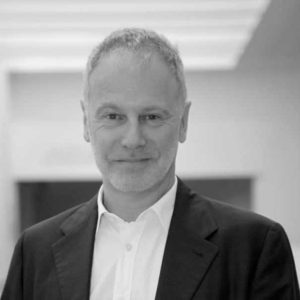LOOP Barcelona Interviews Centro Botin’s director Benjamin Weil

Benjamin Weil, director of Centro Botín, joined the LOOP jury for the edition of 2018. He tells LOOP about his thouhgts on collecting.
How would you define collecting?
The action of accumulating works of art with a purpose. That is to say, any kind of collection is the result of choices, established with more or less conscious criteria. In the case of a public collection, the criteria are probably more established, more spelt out, and relate to its function as a cultural service. In the case of Fundación Botín, the collection is built along two axes: the first is the collection of works by internationally established artists the foundation invited to teach a workshop and present their work at Centro Botín (since 2017 – before that, in the Fundación Botín exhibition space). It includes artists such as Miroslav Balka, Lothar Baumgarten, Tacita Dean, Mona Hatoum, Joan Jonas and Julie Mehretu. The second line of collecting is the acquisition through donation or purchase of works by younger artists who have once been grantees of the foundation’s visual arts grants programme. We have works by Leonor Antunes, Jacobo Castellano, Leticia Ramos and Oriol Vilanova, among many others. The foundation has been acquiring works for the past 25 years, but I believe we have had a more clear collecting strategy for the past 10 to 15 years.
Do you think that collecting has an inherent and cultural aspect to it?
Not sure I understand the question. If we stick to collecting art, which I guess is what interests us here, it of course does. Art is a form of cultural production, and collecting works participates in supporting artists and the galleries that promote them. I would also add that if the collection is made accessible to the public, its cultural relevance is even more evident. This said, many private collectors lend works to public exhibitions, so it seems to me that collecting is a cultural endeavor in any case.
What role can public and private collections play in shaping the contemporary art scene?
As stated earlier: collecting implies supporting the artists and the galleries that help them shape their careers. Collecting with the goal of public display has perhaps a more profound impact in that it also gives exposure to artists, and helps disseminate their work to art professionals and the general public alike. I am not so interested in the market aspect of things, but I guess one could also think about the impact of acquisitions by prominent art institutions as well as important private collectors.
What do you think are the challenges related to collecting artists’ films and videos?
Technology is complicated. There is of course the issue of obsolescence and format change: over the past 30 years, we have gone from having ¾ inch masters with VHS exhibition copies to hard drives and usb sticks and many instances in between. The whole issue of definition is key. For instance, an early work by Bruce Nauman, conceived to be shown with analog projectors, will not look the same if shown in a digital transfer. The question is then to know how one deals with those conservation issues. The Matters in Media Initiative, launched by the New Art Trust in the late 1990’s in collaboration with BAVC, SFMOMA, Tate and then MoMA has been exemplary in its attempt to set guidelines for both collection care and display. To my knowledge it continues to be the most forward thinking initiative of the kind, as it brings together curators, conservation experts, technicians, as well as other museum professionals. See http://mattersinmediaart.org/ for more information.
Do you think there is an increasing attention towards video from the part of private collectors?
Since the early 1970’s video has been a media used by artists. But even before, they used 8mm and 16mm film. In a culture where the moving image becomes more and more prevalent, it is not a surprise an increasing number of artists uses the moving image as a medium to carry out their artistic research. I would say that while some use film or video primarily, many more have included the moving image as part of the palette of media they use in their work. Collectors of art therefore end up collecting moving images – and probably more video than film – because an increasing number of important artist make art using them.
Do you think that the limited edition model can or should coexist with the free streaming of online video content?
I believe it is something each artist has to decide for her/his work. It is a bit like whether artists should consider screening their films in cinemas. In some cases, it may be relevant, in others, not. Some work may be conceived for uncontrolled distribution and then it is a different case altogether. Otherwise, the main problem with online distribution is that one cannot control the size or the definition of the display; this in turn may considerably affect the experience of the work. I personally am in favor of looking at art in the right context, and the museum or gallery still is the best for that. It ensures in most cases that the viewing conditions will be ok, and that the public will be able to grant their undivided attention to the work of art. But then, as with the case of art books, for instance, streaming can be a fantastic research tool.
Benjamin Weil is the artistic director of the Centro Botín (Santander, Cantabria, Spain) since the beginning of 2014. The Centro Botín opened its doors during the summer of 2017, giving a new dimension to the Visual Arts program that the Botín Foundation had been developing for 25 years. Before his arrival to Cantabria, Weil was the artistic director of the Laboral Centro de Arte y Creación Industrial (Gijon, Asturias, Spain), a production, research and dissemination platform for contemporary art and new cultural forms resulting from the creative deployment of novel technologies. Born and raised in Paris, Benjamin Weil developed his career in the United States, where he worked as an independent curator, art critic, conservator and director for several institutions; he held the position of director of the Media Art department at San Francisco Museum of Modern Art (SFMoMA, San Francisco, USA), and of executive director of Artists’ Space (New York, USA). He also started the video art programme H BOX at the Fondation d’Entreprise Hermès (Paris, France), being its artistic director from 2005 to 2011.
What to read next

Ferran Barenblit, MACBA director and part of our jury, shares with LOOP Barcelona his thoughts on collecting
Tuesday 18 December 2018

LOOP Barcelona interviews Wiels artistic director Dirk Snauwaert
Tuesday 18 December 2018

LOOP Barcelona interviews curator Marcella Lista
Tuesday 18 December 2018